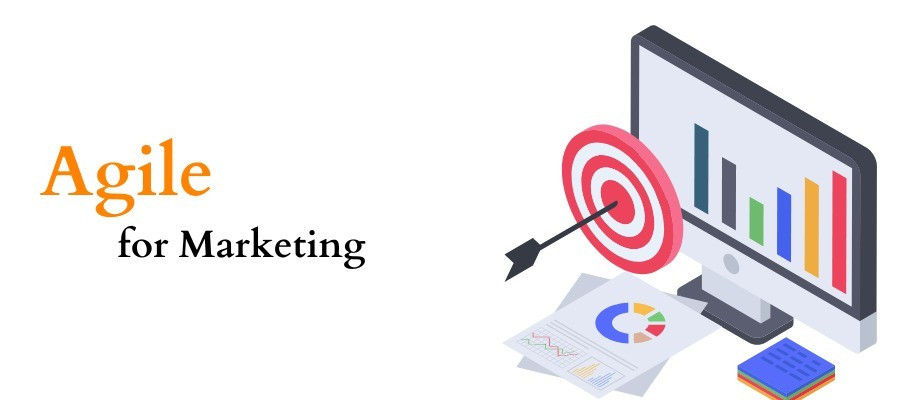Agile for Marketing: How Agile Methodologies Can Improve Marketing Campaigns and Product Launches

The fast-paced nature of the marketing industry demands a dynamic approach to content creation, rendering traditional methods ineffective. Creating content often takes a considerable amount of time. It could not be updated frequently, leading to a mismatch with the evolving interests and requirements of the target audience.
Adopting Agile marketing methodologies allows your marketing teams to publish content swiftly, continually rework it based on performance, and adjust your strategies to respond to changes in the market. By launching campaigns and websites in a preliminary form, you can be revisited later for revision, ensuring that you remain relevant and engaging.
The Agile approach to marketing draws inspiration from the software development process, where Agile techniques are employed to accelerate product launches. You can utilize similar Agile methodologies to quickly reach potential customers with your content, obtain feedback, and fine-tune your approach accordingly.
What is Agile marketing?
Agile marketing employs the principles and practices of Agile methodologies to enhance marketing strategies. This involves forming self-organizing, cross-functional teams that work in frequent iterations with continuous feedback, all guided by a strategic vision and marketing planning for the short, medium, and long term. Agile marketing differs from traditional marketing by emphasizing frequent Releases, deliberate experimentation, and an unwavering commitment to audience satisfaction.
The Agile Marketing Manifesto, created in 2012 by a group of Agile marketing practitioners, is a reference and guide for implementing Agile marketing practices. The manifesto values customer value and business outcomes over activity and outputs, delivering value early and often rather than waiting for perfection, Learning through experiments and data instead of opinions and conventions, fostering cross-functional collaboration over silos and hierarchies, and responding to change rather than sticking to a static plan.
While each implementation of Agile marketing may vary based on organizational context, all versions of Agile marketing share these key characteristics.
What are the characteristics of Agile marketing?
Successful Agile marketing teams share four key characteristics: Agile-based teamwork, data-driven decision-making, rapid and iterative Releases, and adherence to the Agile Marketing Manifesto.
- Agile-based teamwork and collaboration
Agile marketing relies on teams that work collaboratively and embrace Agile working methods. Instead of silos and hierarchies, teams are encouraged to communicate freely and collaborate across all aspects of a project. Regular team-wide meetings and communication channels facilitate collaboration.
- Data-driven decision making
Data drive Agile marketers and take a data-driven approach to market campaigns and product launches. They rely on data to measure and adjust their efforts, constantly developing new experiments to boost performance.
- Rapid, iterative Releases
Agile marketing teams use short sprints to complete a set amount of work, allowing them to produce iterative work Releases within the sprint timeframe. Sprints offer the flexibility to adjust plans of action every few weeks.
- Commitment to the Agile Marketing Manifesto
Agile marketing teams prioritize the values and principles outlined in the Agile Marketing Manifesto, which include focusing on customer value and business outcomes over activity and outputs, delivering value early and often, Learning through experiments and data, fostering cross-functional collaboration, and responding to change. These values and principles guide all groups, such as standups, sprints, and Kanban boards.
These characteristics enable teams to work more efficiently, respond quickly to change, and achieve their marketing goals.
Benefits of Agile marketing
Goal-oriented implementation: Agile marketing is best employed to achieve a specific goal or address a pain point rather than being implemented for its own sake.
Speed and productivity: Agile marketing allows for faster value delivery through changes in organizational structure, team planning, and execution of marketing activities. Cross-functional teams work autonomously, cycling quickly through work items without stalling due to dependencies.
Transparency and collaboration: Through visualised workflows and frequent touchpoints, agile marketing attempts to create visibility into team activities. This transparency and cooperation are achieved through tools like Kanban boards and daily standups that provide full process transparency and enable effective collaboration.
Flexibility: Agile marketing teams use iterative planning to deliver viable work and adapt to changing circumstances. Instead of blindly following an annual marketing plan, teams focus on defining long-term goals and figuring out details along the way, allowing them to change course based on data and customer feedback quickly.
Data-driven success: Agile marketing emphasizes experimentation and aligning campaigns with data to measure success. Agile marketers collect impact KPIs from low-risk experiments, monitor team efficiency, and run small tests to improve campaigns over time, resulting in informed decisions and continuous improvements.
Increased competitiveness: Agile marketing promotes incredible speed, continuous feedback, and adjustment of campaigns when necessary, allowing for a greater focus on consumer needs and improved return on marketing investments. The lessons learned are applied to the next project, keeping campaigns competitive and up-to-date.
Conclusion
Agile marketing has become the new norm for marketers due to its frameworks' ability to meet modern marketing needs. Over the past decade, marketers have significantly progressed in adapting Agile frameworks to their needs.
Reference
- https://www.atlassian.com/agile/agile-marketing/what-is-agile-marketing
- https://www.mckinsey.com/capabilities/growth-marketing-and-sales/our-insights/agile-marketing-a-step-by-step-guide



